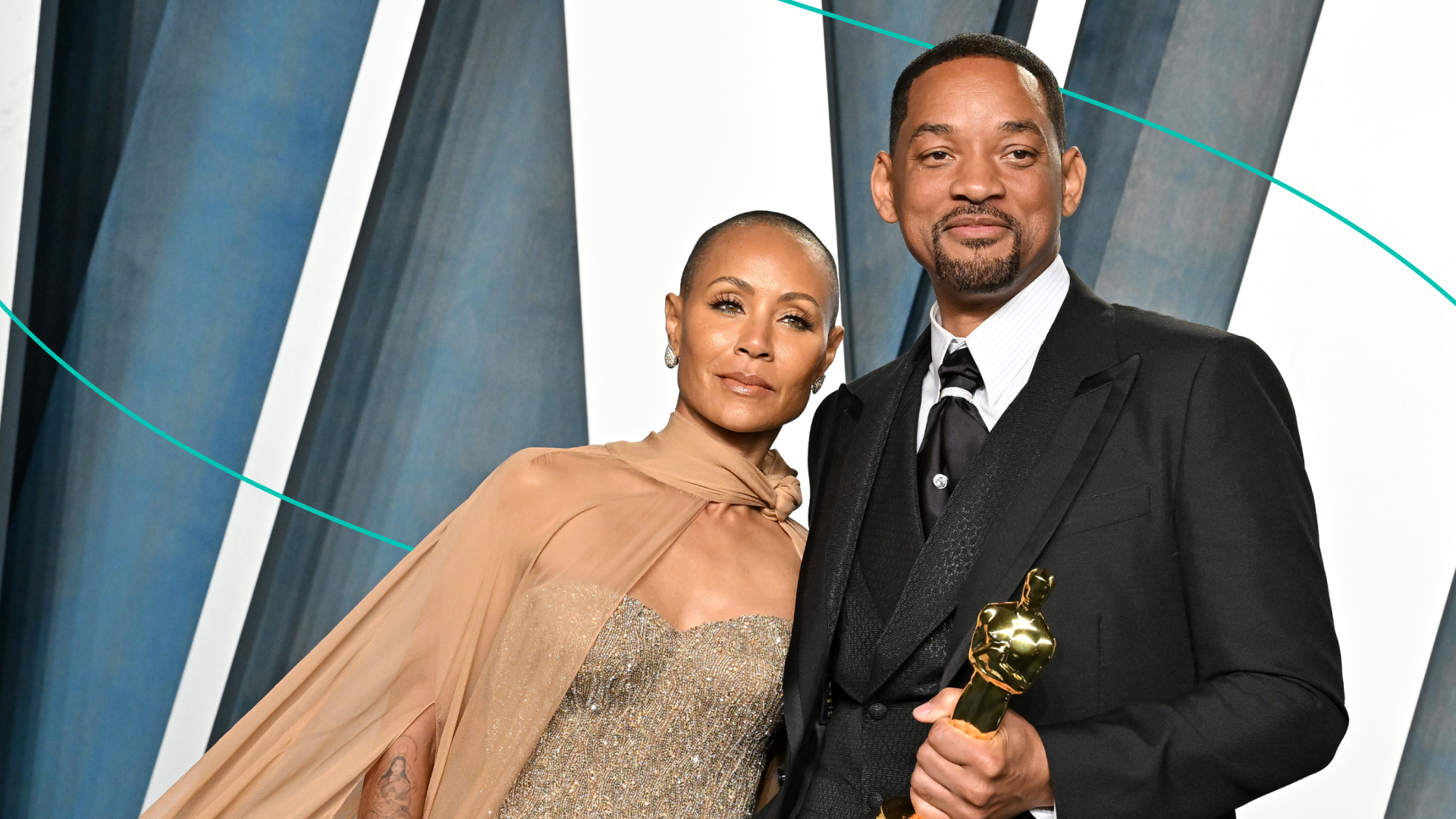Things we didn’t expect from the 2022 Oscars: The most-discussed moment of the night to involve a slap in the face. And a hair loss disorder.
Quick refresher: At Sunday’s ceremony, presenter Chris Rock made a joke that compared Jada Pinkett Smith and her shaved head — a fashion choice influenced by her alopecia — to G.I. Jane. In response, she rolled her eyes, and husband Will Smith went onstage and hit Rock in the face. The unscripted scuffle left celebs’ jaws on the floor.
It also got people asking questions, about the big clash — and also the condition Pinkett Smith has.
The “Red Table Talk” host has been open about the fact that she has “struggled with” alopecia since talking about why she was wearing a turban in a 2018 episode of her Facebook Watch show. Specifically, she appears to have alopecia areata (AA), an autoimmune disease that causes small patches of hair to fall out. And at the end of last year, she got real with Instagram followers about buzzing her hair to deal with a new bald spot.
“Mama’s gonna have to take it down to the scalp so nobody thinks she got brain surgery or something,” she wrote, cheekily, in her video caption. “Me and my alopecia are going to be friends… period!”
Pinkett Smith has been shining a light on alopecia for years. But you still might be confused about what it is. To help, we called up Dr. Kristen Lo Sicco, a dermatologist at NYU Langone Health — who is currently presenting about alopecia at an annual American Academy of Dermatology Association conference in Boston— to break it down.
What is alopecia?
Alopecia “is the general umbrella term for any type of hair loss,” Dr. Lo Sicco said. An estimated 50% of women experience some kind of hair loss in their lifetime.
Alopecia areata is an autoimmune disease. Meaning it’s a condition where your immune system mistakenly attacks the body. In this case, white blood cells go after hair follicles, causing hair to fall out. (Though the hair follicles are rarely destroyed, so there’s a chance the hair can grow back.)
It affects 2% of the population, Dr. Lo Sicco said. And it often leads to small, round bald spots in the face and scalp. It can all happen quite suddenly. Think: over just a few days or weeks. And the hair might grow back, and maybe fall out again. In rare instances, AA can lead to alopecia totalis (total hair loss on head and neck area) or alopecia universalis (total body hair loss).
The hair loss itself doesn’t hurt physically, but it can be emotionally painful.
“Hair is personal. Hair often defines our sense of self, and its loss can rob someone of their identity,” Dr. Lo Sicco said. “For women, hair is viewed as a sign of social power, of beauty, of vitality.”
Pinkett Smith said back in 2018 that she “was literally shaking with fear” when she had clumps of hair fall out in the shower. But she’s come around to embracing her new look. “Mama’s gonna put some rhinestones in there… make me a little crown,” she said on Instagram in December about covering her hairless patches.
Dr. Lo Sicco said, “We should encourage people to be comfortable in their own skin, whether or not they have hair.” And empathy for anyone who’s struggling goes a long way, she adds.
Is alopecia genetic?
The cause of alopecia is “multi-factorial,” Dr. Lo Sicco said. That means it can be a mix of genetics (as one in five people with AA has a relative who’s experienced it), external risks (think: chronic stress, viral infection, even allergies), and internal risk (such as: thyroid disease, vitamin deficiencies). And there are studies that suggest Black and Hispanic women are more likely to have alopecia areata than white women, though the disparities aren’t largely understood.
Thing to know: thinning hair — which women sometimes experience during major hormonal changes like after menopause — is typically a different kind of alopecia. That’s “androgenetic alopecia” if you want to be technical, or “female pattern hair loss.” And it's much more common.
What are the signs and symptoms of alopecia?
Losing around 100 strands of hair a day: normal. Not that you’re necessarily counting. But Dr. Lo Sicco said you know your body best, and if you’re noticing a pattern of more hair coming out than usual, then it might be time to make an appointment with a board-certified dermatologist. And the earlier you can seek care, the better.
Can alopecia be treated?
There are treatments that can help hair grow back and work to prevent future hair loss. But for most forms of alopecia, there is no cure.
If you visit a derm about your hair loss, they might ask about your family history, conduct a physical exam (which can include using a special microscope on your scalp), and order blood tests (to see if a hormonal imbalance or vitamin/mineral deficiency could be part of the problem). All of this to figure out if you have alopecia, and what kinds of treatment could help you with it. That is, if you even want to consider treatment.
As Dr. Lo Sicco said, "it's a personal choice" whether to work toward getting all of your hair back, or shave it all off like Pinkett Smith. "Either way it should be accessible, and nobody should ever be made feel guilty for choosing either option."
Treatment options for hair loss can include:
Topical medication to stimulate hair growth. Think: Rogaine, the brand name of Minoxidil you probably know. Dr. Lo Sicco said that oral Minoxidil prescriptions have also become available in the last decade.
Laser therapy. Yes, some people laser off their hair. But low-dose lasers and phototherapy are used to help get hair back. Those are backed by less scientific evidence than other treatments listed here, but “can serve a role” in treatment, Dr. Lo Sicco said.
JAK inhibitors. The FDA approved the drug Olumiant (baricitinib) on June 14 to treat adults with severe alopecia. It’s the first approved option for “systemic treatment,” which means it treats the whole body. The drug works by blocking inflammation in the hair follicles that leads to hair loss. And similar drugs could be on the way. Dr. Lo Sicco said the treatments could be “game changers.”
Treatments for alopecia aren’t always covered by insurance, Dr. Lo Sicco said. And they can be costly. JAK inhibitors had previously been approved only for rheumatoid arthritis, another autoimmune condition. But Dr. Lo Sicco said she hopes the new FDA approval will help to expand access to affordable and effective treatment options. Dr. Lo Sicco called this an “important moment.”
Alopecia has very real psychological consequences. Note: Dr. Lo Sicco is also pushing Congress to approve a bill that would provide coverage for wigs as “durable medical equipment” under the Social Security Act.
For the mental health side of alopecia treatment, it might be worth looking into support groups (Dr. Lo Sicco has one called Alopecia Justice League) and forms of talk therapy.
theSkimm
Alopecia areata — the condition that Jada Pinkett Smith likely has — is an autoimmune disease that’s still not fully understood with no known cure. What we do know: Treatment options are available. And if you're dealing with hair loss, you're not alone.
Updated June 14 to include FDA approval of the JAK inhibitor baricitinib.
This content is for informational and educational purposes only. It does not constitute a medical opinion, medical advice, or diagnosis or treatment of any particular condition.
Subscribe to Skimm Well
Sign up here to receive our wellness newsletter filled with actionable advice, expert-vetted content, product recs, and more — delivered directly to your inbox.

